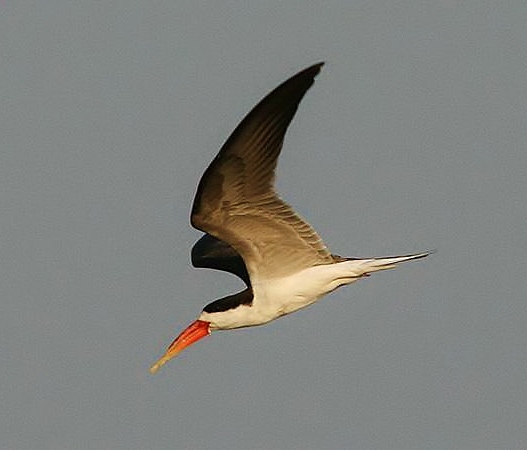 |
| Photo by Aleix Comas (Internet Bird Collection) |
Common name:
African skimmer (en); talha-mar-africano (pt); bec-en-ciseaux d’Afrique (fr); rayador africano (es); braunmantel-scherenschnabel (de)
Taxonomy:
Order Charadriiformes
Family Rynchopidae
Range:
This species is found in most rivers and lakes in sub-Saharan Africa, from southern Mauritania, southern Mali, Chad and southern Egypt south to northern Namibia, Zimbabwe and southern Mozambique.
Size:
These birds are 36-42 cm long and have a wingspan of 106 cm. They weigh 110-200 g.
Habitat:
The African skimmer is found in broad rivers, coastal lagoons, open marshes and lakes with expansive, exposed sandbars and islands. They occur from sea level up to an altitude of 1.800 m.
Diet:
They mainly feed at dusk, dawn and during the night, flying over calm waters and dipping their lower mandibles in the water to catch fishes such as Micralestes acutidens, Tilapia, Barbus, Marcusenius macrolepidotus, Hepsetus odoe, Aplocheilichthys or Petrocephalus catostoma.
Breeding:
African skimmers breed in March-November. They form loose colonies of up to 50 pairs, each nesting in a scrape on the ground in a sandbar. There the female lays 2-4 eggs which are incubated by both sexes for 20-22 days. The chicks leave the nest within 1-2 days of hatching, being led to the water by the parents who protect them from heat and regularly feed them. They start flying 5-6 weeks after hatching but only become fully independent a few weeks later.
Conservation:
IUCN status – NT (Near-Threatened)
This species has a very large breeding range but the global population is estimated at just 10.000-17.000 individuals. The population is suspected to be in decline owing to wetland habitat degradation caused by dam-building and farming practices. Over-exploitation of eggs and adults, and human disturbance are additional problems.







